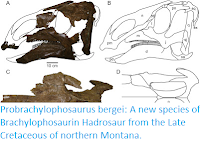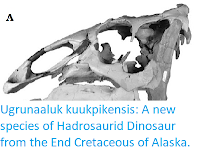The Rhabdodontids are a group of Iguanadontid Ornithischian Dinosaurs known only from the Late Cretaceous of southern Europe. They were predominantly large, robust animals, though dwarf species are known from the Haţeg Basin of Romania, deposits interpreted as having been laid down on a relatively small island, which contain dwarfed species of a number of Dinosaur groups. Most Iguanadontids resemble the related Hadrosaurs, in that they developed ever larger batteries of small, closely packed crushing teeth over time, interpreted as an adaptation to precessing hard, woody, plant material. However, the Rhabdodontids differ from this pattern in that they showed both a reduction in tooth number, and enlargement of the individual teeth, over time, suggesting a different feeding strategy.
In a paper published in the journal Scientific Reports on 26 October 2017, Pascal Godefroit of the Directorate ‘Earth and History of Life’ at the Royal Belgian Institute of Natural Sciences, Géraldine Garcia of the Université de Poitiers, Bernard Gomez of the Laboratoire de Géologie de Lyon, Koen Stein of the Chemistry Department at the Vrije Universiteit Brussel, Aude Cincotta, also of the Directorate ‘Earth and History of Life’ at the Royal Belgian Institute of Natural Sciences and the Department of Geology at the University of Namur, Ulysse Lefèvre, again of the Directorate ‘Earth and History of Life’ at the Royal Belgian Institute of Natural Sciences, and of the Department of Geology at Liège University, and Xavier Valentin, also of the Université de Poitiers, and of the Palaios Association, describe a new species of Rhabdodontid Dinosaur from the Begudian Sandstones of the Aix-en-Provence Basin in the Bouches-du-Rhône Department, Provence region of southern France.
The new species is named Matheronodon provincialis, where 'Matheronodon' means 'Matheron's Tooth', in honour of Philippe Matheron, the nineteenth century French geologist and palaeontologist who was the first person to describe Dinosaurs from the Provence region, and 'provincialis' means 'from Provence'. The species is described from a single right maxilla (upper jawbone) and a number of detached teeth.
Right maxilla of Matheronodon provincialis in dorsal (a), lateral (b), medial (c), and ventral (d) views. (e) Close-up of the second and third maxillary crowns. Godefroit et al. (2017).
Matheronodon provincialis shows extreme reduction in tooth number, with only eight teeth present on each side of the upper jaw, and presumably a similar number on the lower jaw. These teeth are greatly elongated, reaching 5 cm in length, and extremely thin and blade-like, with a ridge-pattern that favoured sharpening as the teeth wore down, making the species particularly extreme even for a Rhabdodontid in this regard. Godefroit et al. note that Hadrosaurs and non-Rhabdodontid Iguanadontids are typically associated with floras dominated by Conifers, plants which produce abundant woody material requiring considerable processing before it can be swallowed. The areas where Rhabdodontids are found, in contrast, had become dominated by Monocots such as Sabalites and Pandanites. These plants produce little woody material, but have large fibrous leaves, difficult to remove with crushing teeth, but presumably easier to process with the shear-like teeth seen in Rhabdodontids.
Reconstruction of Matheronodon provincialis showing large, blade-like teeth. Lukas Panzarin/Royal Belgian Institute of Natural Sciences.
See also...
Follow Sciency Thoughts on Facebook.








